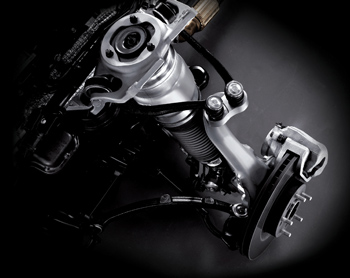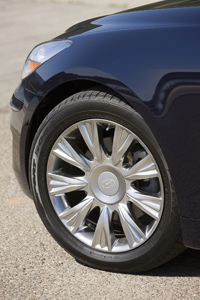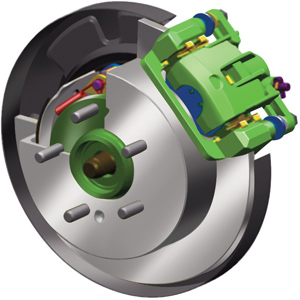It seems I’ve been writing a lot of these brake and undercar articles lately. While they’re similar in content, I hope you find them to be resourceful, and it never hurts to go over the basics. This month, we’ll be concentrating on the Hyundai line of vehicles. Over the years, these cars have seen improvements in performance and reliability. The latest models have certainly touched a chord with the buyers, and with smart styling, affordability and a strong dealer network, there is no reason to think you won’t be seeing these cars in your bays for many years to come.
Any problems with the brake and suspension systems on Hyundai’s popular line of cars and SUVs can be detected during routine maintenance. From loose ball joints to worn-out brakes, it’s all there to be checked while the vehicle is on the rack for service and, oftentimes, the driver has no idea there’s a problem. That’s why it’s so important that we recommend routine maintenance to our customers. It not only helps your bottom line, but also lets the customer know you’re willing and able to take care of all the recommended maintenance their Hyundai requires, and that the safe operation of their vehicle is your primary concern.
 SUSPENSION NOISES
SUSPENSION NOISES
Like any other problem, the more information we can get from the driver regarding suspension-related noises, the better. Many times, the best tactic is to have a tech road-test the car with the customer to be sure of the noise you’re chasing. At the same time, it’s a good idea to do a thorough safety inspection.
Grab the wheel at the 9 o’ clock and 3 o’ clock positions and shake the wheel side-to-side, checking for looseness in the steering system. It doesn’t take a violent shake to feel the looseness, just firm input. If you feel some play, have an assistant look for the movement, concentrating on inner and outer tie rod ends, side movement of the ball joint, control arm bushings and wheel bearing play. Move your hands to the 12 o’ clock and 6 o’ clock positions and do the same thing. Here you’ll pick up play in the strut shaft or mounting, ball joint and control arm bushing, and if there was any wheel bearing play in the shake test, it will also be noticeable. Finally, spin the wheel to check for noises and brake drag.
If play in the bearing is noticed, it should be taken care of whether it’s quiet or not. Check the torque on the axle nut; if it’s loose you’ll have to make a judgment call — has someone been in there or is the bearing or hub showing wear? If the play is excessive, the re-torque has no effect and the bearing isn’t growling, it would pay to be sure a hub is available before the car is disabled on the lift.
Suspension noises will usually present themselves in a couple of ways; knocking, squeaking and creaking are the most common. Squeaking noises are often the result of tie rod ends and ball joints binding up as a result of rust buildup. Tie rod ends can be checked with the car in the air by twisting the rod; ball joints can usually be confirmed with a knee to the bumper.
While you’re pushing, you can’t help but check the struts’ dampening condition, but it’s rare to have a noise caused by the strut itself. Using your technicians’ stethoscope, it’s not difficult to find the offending joint and don’t overlook the sway bar links.
With many Hyundai models using ball-and-socket-type links, they’re prone to the same type of failure and creaking noise. Like the tie rod end, a quick twist with the pliers should pick it up. We’ve had cases where putting the car up on a frame contact lift and allowing the suspension to droop temporarily eliminates the noise.
While a real loose tie rod end or ball joint can make a knocking noise, they can typically be a little more difficult to track down. Don’t overlook the sway bar and its attaching hardware. Any looseness here will result in a noise that is louder than you’d expect. Check the chassis mounting bushings by gently prying against the sway bar and look for any movement; there should be none. Same with the links; any movement will result in a very noticeable knocking noise.
The only repair warning on the mounting bushings is to be careful when removing the bolts that secure the horseshoe bracket to the subframe. Don’t be stingy with penetrating oil and use heat if necessary. Breaking the bolts will turn a good job ugly in a hurry.
Removing the nuts on the links might be challenging as the rust on studs will cause the stud to spin. If faced with that situation, separate the joint exposing the ball end of the stud. A well-placed pry bar or air chisel hit is usually all it takes. With the ball exposed, grab it with a pair of locking pliers, making quick work of the replacement.
While doing your visual inspection, keep an eye out for rust around the mounting hardware. Where there’s rust there is movement, and where there’s movement there will be noise. When checking for tightness, always loosen the bolt, then retighten to the proper torque so you’re not tricked into thinking it’s tight when it’s actually stuck in the threads.
 VIBRATION, DRIFTING & PULLING COMPLAINTS
VIBRATION, DRIFTING & PULLING COMPLAINTS
While we’re concentrating on noise complaints, there are some other common suspension issues that will drive customers to your shop, the most common of which are vibration, drifting or pulling complaints. The most important thing to keep in mind is that it’s the tires that connect the car to the road. If the tires are in poor condition or are mismatched, or if you notice excessive or uneven wear, suggest they be replaced.
Like noise complaints, it’s always a good idea to road-test vibration complaints with the customer because a vibration can mean different things to different folks.
Even after you ask all the right questions — When does it shake? Where do you feel it? Steering wheel, or through the seat, on the brakes, under load or while coasting? — there’s still a good chance for miscommunication, but a road-test will make it clear.
Since Hyundais have a FWD configuration, we have to keep in mind that axle problems will be presented as suspension complaints. The customer only knows that he/she hears a noise or feels a shake that seems to be coming from under the car. That’s why the initial road-test is so important.
When road-testing, make note of when the shake occurs and how it reacts to driver inputs. If you can drive through the vibration, suspect a tire balance problem. If the vibration seems to change with the load, look for worn inner CV joints. On high-mileage cars, it can be difficult to pick out the offending joint. If both inner joints show excessive wear, the best course of action is to replace both.
Most poor-handling complaints will have the customer requesting a wheel alignment. Hyundai gives us very little alignment adjustment; on most models, only toe is adjustable. Of course, having the proper toe setting is important to handling as well as tire wear. But it won’t usually change enough to cause a handling problem.
Ask if there were events that led to the car’s handling problem. Were the tires recently replaced or rotated, or did your customer have a flat repaired or put air in the tires? Here in the Northeast, suspension-damaging potholes are a very real threat, but it sometimes takes a reminder for the customer to relate them to their problem.
Handling complaints can vary, but most come down to the car doesn’t go straight or it wanders. The first place to look is at the tires’ condition and pressure. Don’t overlook tire sizing; it takes minutes to measure the circumference and the ideal situation is they’ll all match. But anything more than a 1/8-inch variance will cause a pulling problem. Wandering problems caused by loose parts should have been found during the initial inspection, but if nothing was found there, check the toe.
 BRAKE-RELATED COMPLAINTS
BRAKE-RELATED COMPLAINTS
Another undercar system that can be responsible for more noise complaints than the suspension are the brakes. Most complaints will be squeak-related, with the common metal-on-metal grinding taking a close second. Both of these noises relate to the pad. The grinding noise is almost always the result of worn pads and the backing plate contacting the rotor, and we all know how to deal with that. To a lesser extent, you’ll also get some knocking complaints.
Squeaking can be the most challenging and is often evident after the brakes have been serviced. The best way to deal with brake squeal is to prevent it in the first place. While we’re all familiar with brake service, it never hurts to review good practices.
By now, I’m sure we’re all aware of the risk involved with pushing contaminated brake fluid backward through the anti-lock brake system. The risk of creating blockages in the ABS modulator is just too great to overlook. There’s really no reason not to open the bleeders and slowly retract the pistons, catching the bad fluid in your bleed bottle.
You’re going to bleed and flush the system as part of the service, so you might as well get rid of the most abused fluid right off the bat.
Those of us in the Northeast may see more problems that are related to the snow and salt, and the procedures used to deal with the elements, than the warm-weather guys. But no matter where you live, there’s no debating that brakes live in a hostile environment that results in rust and corrosion that have to be taken care of to ensure a quality and quiet repair.
As the pads are being removed, it’s important to look for anything that isn’t moving freely and for pads that are worn evenly. These are indicators that the workload isn’t being distributed evenly and there’s a good chance that the pads are hanging up.
As the pads are being replaced, the system inspection should continue. Open the bleeder and push back the pistons on the calipers. On the front, we use a C-clamp between the outer pad and the back of the caliper. It should take little effort to retract the piston and move the caliper away from the outer pad. If excessive effort is required, don’t force it; instead look for an indication of what’s binding and remove the caliper to further investigate. If the slides are frozen, it will be evident if the piston retracts easily with the caliper removed.
Make note if the pads are sticking in the carrier; either way, lubricate and service the sliders as well as the carrier. Be sure to remove the anti-rattle hardware in the bracket to clean the rust behind them; it’s that rust that will bind the pads, and any binding will result in noisy operation as well as poor brake performance. When installing the new pads, be sure to lubricate any area where the pad contacts the bracket, and insulate the pad backing from the piston and caliper.
Squeaks are the result of the pads vibrating against the piston and bracket when the brakes are partially applied. If possible, always reinstall the insulator shims with a little brake lube between the shim and the pad. If the shims aren’t available or aren’t reuseable, there are a couple of options. We’ve had better luck with the chemical compounds, over the universal shims that are available. Use what works best for you, but using nothing is a sure recipe for noise. We also use an aerosol product that gets applied on the new friction material and have had good success with it preventing noiserelated comebacks.
It’s always a good noise-prevention practice to replace the rotors when pads are replaced. Of course, we live in the real world and that’s not always possible. If you’re installing new pads against the old rotors, be sure the pads aren’t going to contact an area of the rotor that the old pads didn’t. In some cases, the unused area of the rotor can be cleaned up. In others, it’s best to advise the customer and note on the invoice that without replacing the rotors noisy operation is a possibility.
You’ll also see many of these cars equipped with drum brakes in the rear that will add to the noise issues. The most common is a grinding noise caused by accumulated brake dust that’s most noticeable when the vehicle’s driven after a prolonged stop. The debris will collect at the bottom of the drum, causing a noise that will go away as the car is driven. The repair is as simple as cleaning the drums and brakes, and giving the system a good visual inspection.
Don’t overlook the hardware in that inspection; you can avoid a future noise complaint caused by broken hardware being ground up in the drum by identifying any bad hardware now. Another concern is a buildup of rust on the drum that causes interference with the backing plate. Depending on the extent of the rust, it can be cleaned off, but it’s often more cost-effective to simply replace the drums.
The last noise we’ll talk about is a knocking noise, and it’s the brake pads rattling in the brackets. Like the sway bar bushings, it takes very little movement to result in a pretty big noise. Diagnosis is straightforward and can be performed on the initial road-test.
As you’re driving over that potholed road, just apply light pressure to the brake pedal; not enough to slow the car, just enough to hold the pads tight. If the noise is gone, you can bet the pads are moving. This driving scenario will also highlight any brake squeak noises you weren’t able to duplicate. If the pads are moving, a hardware kit should provide you with all the parts needed.
I hope this look at some of the undercar noises we encounter will help you tackle these issues on Hyundais, as well some of the other cars that you find in your bay. They’re not difficult to diagnose or repair, and if you do need help, there’s no reason to be without Hyundai factory repair information. This carmaker wants us to have all the information we need to repair its vehicles. You can see for yourself; go to the Hyundai’s service information website, www.hmaservice.com, and register.
After you register, spend time looking around making of note of the resources available. There are good details on ABS, active suspension and vehicle stability systems that should reinforce the need for the good work habits that we just discussed. These computer-controlled driver’s aids are dependent on the systems they control to operate as designed. If you have any doubts, take a look at TSB 10-BR-001 on brake service best practices. It covers the same things we just talked about here. And, while you’re there, take a look at some of the other brake service bulletins and think about the time that could be saved with a quick look at the list as part of your diagnostic process.






